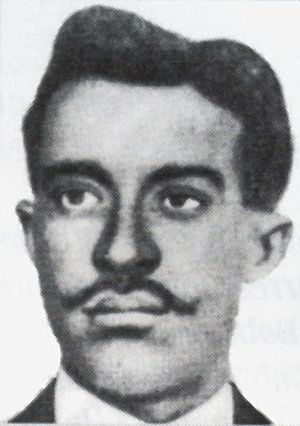Charlemagne Péralte facts for kids
Quick facts for kids
Charlemagne Péralte
|
|
|---|---|
 |
|
| Birth name | Charlemagne Masséna Péralte |
| Born | October 10, 1886 Hinche, Republic of Haiti |
| Died | November 1, 1919 (aged 33) Near Grande-Rivière-du-Nord, United States occupation of Haiti |
| Buried | |
| Allegiance | Republic of Haiti (before 1915) Cacos (after 1915) |
| Years of service | 1904–1919 |
| Battles/wars | United States occupation of Haiti |
Charlemagne Masséna Péralte (born October 10, 1886 – died November 1, 1919) was a brave Haitian leader. He strongly opposed the United States occupation of Haiti that began in 1915. Péralte led a group of fighters known as the Cacos. They were a big challenge to the US forces in Haiti. Even though he was eventually killed by American troops, Péralte is still seen as a great hero in Haiti.
Contents
Early Life of Charlemagne Péralte
Charlemagne Péralte was born on October 10, 1886. His hometown was Hinche, a city in Haiti. His father was General Remi Massena Peralte. Péralte's sister was also married to a former President of Haiti, Oreste Zamor.
Fighting for Freedom: The Cacos Resistance
Charlemagne Péralte was a military officer. He was in charge of the city of Léogâne when US Marines arrived in Haiti in July 1915. This was the start of the US occupation.
Péralte did not want to give up to the foreign soldiers without a fight. So, he left his military job. He went back to his family's land in Hinche. In 1917, he was arrested for trying to take money from a police station. He was sentenced to five years of hard labor.
But Péralte managed to escape! After his escape, he gathered a group of Haitian rebels. They started a guerrilla war against the US troops. This means they used surprise attacks and small groups to fight.
The fighters led by Péralte were called "Cacos." This name came from old Haitian rural fighters who had been involved in politics in the late 1800s. The Cacos were very strong opponents. The United States had to send more US Marines to Haiti. They even used airplanes to fight against the Cacos. In 1919, Péralte's forces attacked Port-au-Prince, the capital city. However, they were forced to retreat.
The Death of a Hero
After two years of fighting, Charlemagne Péralte even declared a temporary government in northern Haiti. Sadly, he was betrayed by one of his own officers, Jean-Baptiste Conzé. Conzé led two US Marines, Sergeant Herman H. Hanneken and Corporal William Button, into the rebel camp. The Marines were disguised as Haitian fighters.
Péralte was shot in the heart from a short distance. Hanneken and his men then took Péralte's body away on a mule.
To try and stop Haitians from supporting the rebels, the US troops took a picture of Charlemagne Péralte's body. His body was tied to a door. They shared this picture all over the country. But it had the opposite effect! Many people thought the image looked like a crucifixion. This made Péralte a symbol of resistance and a martyr for his cause.
Charlemagne Péralte's remains were dug up after the US occupation ended in 1935. A national funeral was held for him in Cap-Haïtien. The President of Haiti at the time, Sténio Vincent, attended the funeral. You can still see his grave there today.
Today, a picture of Charlemagne Péralte is on Haitian coins. These coins were issued by the government of Jean-Bertrand Aristide after 1994.
For their actions, Corporal Button and Sergeant Hanneken received the Medal of Honor. This is a very high award for bravery. Hanneken later became a brigadier general. He served in World War II, including at Guadalcanal. In his later years, he did not like to talk about his actions in Haiti.
See also
 In Spanish: Carlomagno Peralta para niños
In Spanish: Carlomagno Peralta para niños

